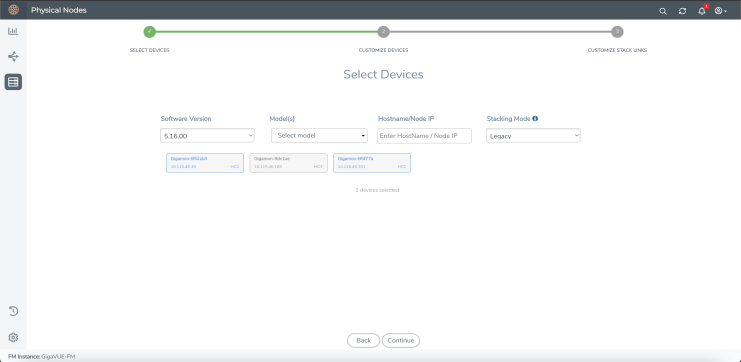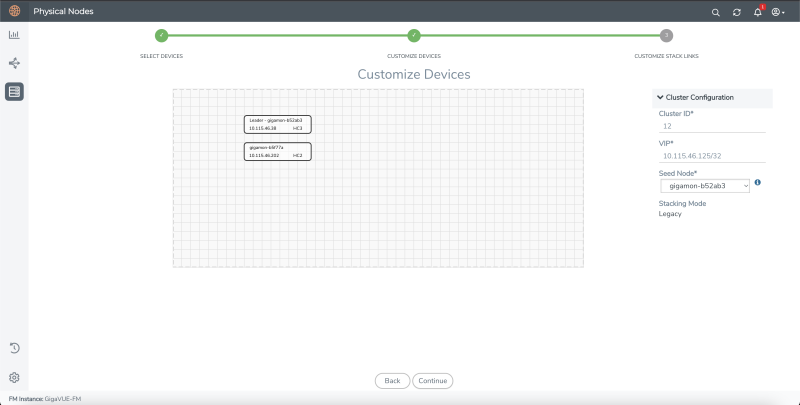Regular Cluster Formation Workflow
Gigamon’s Cluster formation can be done for any number of devices with different combinations of devices.
GigaVUE‑FM supports workflow-based configurations for forming a cluster. This workflow walks through the required steps to form a complete cluster for a regular cluster.
Note: Refer to Leaf-Spine Cluster Formation Workflow for how to use the Leaf-Spine Cluster workflow
Deployment Checklist
Before forming a Cluster, it is strongly recommended that you familiarize with the relevant documentation and review the deployment checklist to prepare for deployment.
Pre-deployment checklist
|
■
|
Gigamon Fabric Management must be upgraded to GigaVUE‑FM 5.3.00 or later. |
|
■
|
Gigamon device must be upgraded to GigaVUE‑OS 5.2.00 or later |
|
■
|
Advanced Features License must be installed in TA devices. |
|
■
|
Physical connection must be established to create stack links. |
|
■
|
Devices must have GDP enabled and be physically connected to create links among devices from GigaVUE‑FM. |
Create Regular Cluster Formation
To create a cluster:
|
1.
|
On the left navigation pane, click  , and then select Physical > Nodes. , and then select Physical > Nodes. |

Select Cluster Type
|
3.
|
The Create a Cluster screen opens with two options: |
|
o
|
Create a Leaf Spine Cluster |
|
4.
|
Hover over the Create a Cluster option and click Let’s Begin to start the wizard. |
Select Devices
The wizard guides you through the cluster set-up. The first step is to select the devices in your cluster.
|
5.
|
The Select Devices page displays a list of standalone devices with filter options: |
|
o
|
Software Version: Filter the nodes based on the software version for which the cluster will be formed. |
|
o
|
Model: Filter the nodes based on a Gigamon model. |
|
o
|
HostName/Node IP: Enter the HostName of the Gigamon Nodes to specify a device. |
|
o
|
Stacking Mode: Select the required Stacking Mode. The following options are available: |
|
o
|
Legacy: Selects the legacy stacking mode. |
|
o
|
Default: Selects the Default stacking mode. |
Notes: - GigaVUE-TA 10 and GigaVUE-HC2CCv1 devices are not supported in Default stacking mode.
- GigaVUE-TA 400 device is not supported in Legacy stacking mode.
|
o
|
Protocol: Select the required protocol based on which the devices will communicate with each other. The following options are available: |
|
o
|
IPv4: Cluster leader and the member nodes communicate through IPv4. |
|
o
|
IPv6: Cluster leader and the member nodes communicate through IPv6. |

|
6.
|
Select the nodes to include in this cluster and click Continue. |
Click a device to select it; click it again to deselect it. Selected devices are highlighted.
Customize Devices
Use the Cluster Configuration window to customize your devices.
|
7.
|
Enter a valid Cluster ID and VIP and select the leader in the Seed Node list. |
Note: The leader cluster preferences in GigaVUE‑FM determines which of the nodes will be the default the seed node. TA devices cannot be a leader.

|
8.
|
After completing the Cluster Configuration details, click Continue. |
Note: Use the Back button to return to the Select Devices page to revise the selection of devices for this cluster.
Customize Stack Links
Finally, customize the stack links to define how the nodes should be connected.
|
9.
|
Connect any two devices to create a stack links between those two devices. |
Click the tip of the node and drag your cursor to the second node tip to create a link. After you create the link, a dotted line will illustrate the connection.
|
10.
|
Configure the formed links in the Stack Links table as follows: |
|
o
|
Select ports in each device that are compatible, for example: x-x ports ,x-q ports, q-c ports, x-c ports. |
|
o
|
Select two or more ports in each device to create a stack GigaStream. |
|
o
|
After selecting the ports, save the stack link by clicking the Save button enabled in the right of stack link table. |
The alias for each stack link and GigaStream is auto generated by GigaVUE‑FM. This alias can be edited as needed.
|
11.
|
After the required Stack Links and GigaStreams are created and saved, click Continue to start the cluster creation process. |
The Creating Cluster page appears as the cluster is being created.
The Create Cluster progress window in the lower right corner of the page shows the status of every node as it joins the cluster. It takes a few minutes for the cluster to form. The cluster creation process involves the following steps:
|
o
|
Cluster[clusterName] Creation Successful followed by Seed device |
|
o
|
Verifying Nodes[Will display HostName of all devices] |
|
o
|
Adding Node[HostName] to cluster [clusterName] |
|
o
|
Node[HostName] successfully joined to the cluster. |
|
o
|
Configuring cards for cluster[clusterName] |
|
o
|
Rediscovering cluster[clusterName] |
|
o
|
Configuring ports for cluster[clusterName]. |
|
o
|
Configuring ports will display the status of each stack link and GigaStream whether the creation is successful or not. |
Note: Refer to Check Cluster Status for Events.
When the cluster formation process is complete the notification window will display a, “Create Cluster Competed,” message.
|
12.
|
Click Go to Cluster to view the cluster overview. |
 , and then select Physical > Nodes.
, and then select Physical > Nodes.





